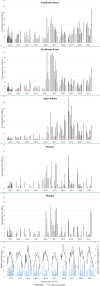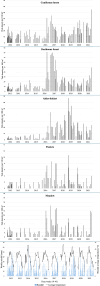Ghosts of weather past? Impact of past and present weather-related factors on the seasonal questing activity of Ixodes ricinus nymphs in southwestern Finland
- PMID: 40660308
- PMCID: PMC12261623
- DOI: 10.1186/s13071-025-06911-y
Ghosts of weather past? Impact of past and present weather-related factors on the seasonal questing activity of Ixodes ricinus nymphs in southwestern Finland
Abstract
Background: Hard ticks are responsible for spreading several zoonotic infections globally. Of the main vector species in Europe, Ixodes ricinus, nymphal ticks cause the largest number of disease cases. Therefore, understanding the seasonal questing behaviour of this life stage is particularly crucial for public health. We assessed seasonal variation in questing abundance of I. ricinus nymphs on a tick-infested island in southwestern Finland. Our primary goal was to examine which abiotic factors, such as meteorological conditions from the recent past, influence the seasonal questing activity of I. ricinus nymphs, and whether these influences manifest similarly across different times and habitat types.
Methods: Ticks were collected in 2012-2021 by cloth dragging from five different biotopes around the island. Three 50-m study transects were placed in each biotope, for a total of 15 transects. Air temperature and relative humidity were measured at the moment of sampling. Daily temperature and rainfall readings were obtained from weather stations.
Results: Across all biotopes, the overall density of I. ricinus nymphs was 10.6 ticks/100 m2. In total, 7082 nymphs were collected from a total sampled area of 67,500 m2. Increasing nymph densities were observed during the 10-year study period, but the increase was not linear. Instead, an incremental jump in densities was observed in 2016. One weather-related explanatory factor remained in each of the statistical models for modelling the seasonal questing activity of ticks, when the progress of the season was already taken into account by week numbers.
Conclusions: Increasing nymph densities were observed during a 10-year study period. While temperature measurements taken during the time of dragging did not appear to greatly influence the observed tick numbers, the recent past temperature variables were significant in all the natural biotopes. The results suggest that, in the clearly seasonal climate of southwestern Finland, the main factors shaping phenological patterns of I. ricinus nymphs during their main activity period are the progress of the season and a heat-related reduction in questing activity.
Keywords: Abiotic factors; Longitudinal study; Temporal tick dynamics; Ticks; Time-lagged effects.
© 2025. The Author(s).
Conflict of interest statement
Declarations. Ethics approval and consent to participate: Not applicable. Consent for publication: Not applicable. Competing interests: The authors declare no competing interests.
Figures







Similar articles
-
Sympatric occurrence of Ixodes ricinus, Haemaphysalis concinna and Haemaphysalis inermis in a wild fauna reserve.Ticks Tick Borne Dis. 2025 Jul;16(4):102491. doi: 10.1016/j.ttbdis.2025.102491. Epub 2025 Jun 4. Ticks Tick Borne Dis. 2025. PMID: 40472544
-
Dynamics of Ixodes ricinus and associated bacterial pathogens in the forest and agricultural ecosystems of northeastern France.Appl Environ Microbiol. 2025 Jun 18;91(6):e0079325. doi: 10.1128/aem.00793-25. Epub 2025 May 29. Appl Environ Microbiol. 2025. PMID: 40439421 Free PMC article.
-
Ixodes ricinus tick presence is associated with abiotic but not biotic factors.Curr Res Parasitol Vector Borne Dis. 2024 Jul 31;6:100206. doi: 10.1016/j.crpvbd.2024.100206. eCollection 2024. Curr Res Parasitol Vector Borne Dis. 2024. PMID: 39224900 Free PMC article.
-
A rapid and systematic review of the clinical effectiveness and cost-effectiveness of paclitaxel, docetaxel, gemcitabine and vinorelbine in non-small-cell lung cancer.Health Technol Assess. 2001;5(32):1-195. doi: 10.3310/hta5320. Health Technol Assess. 2001. PMID: 12065068
-
Impact of residual disease as a prognostic factor for survival in women with advanced epithelial ovarian cancer after primary surgery.Cochrane Database Syst Rev. 2022 Sep 26;9(9):CD015048. doi: 10.1002/14651858.CD015048.pub2. Cochrane Database Syst Rev. 2022. PMID: 36161421 Free PMC article.
References
-
- Földvári G. Life cycle and ecology of Ixodes ricinus: the roots of public health importance. In: Takken A, Sprong H, van Wieren SE, Braks AHM, editors. Ecology and prevention of Lyme borreliosis, vol. 4. Wageningen: Wageningen Academic Publishers; 2016. p. 31–40.
-
- Dantas-Torres F, Chomel BB, Otranto D. Ticks and tick-borne diseases: a One Health perspective. Trends Parasitol. 2012;28:437–46. - PubMed
-
- Kernif T, Leulmi H, Raoult D, Parola P. Emerging tick-borne bacterial pathogens. Microbiol Spectr. 2016;4:ei10-0012-2016. - PubMed
-
- Vandekerckhove O, De Buck E, Van Wijngaerden E. Lyme disease in Western Europe: an emerging problem? A systematic review Acta Clin Belg. 2019;76:244–52. - PubMed
MeSH terms
Grants and funding
LinkOut - more resources
Full Text Sources
Miscellaneous

